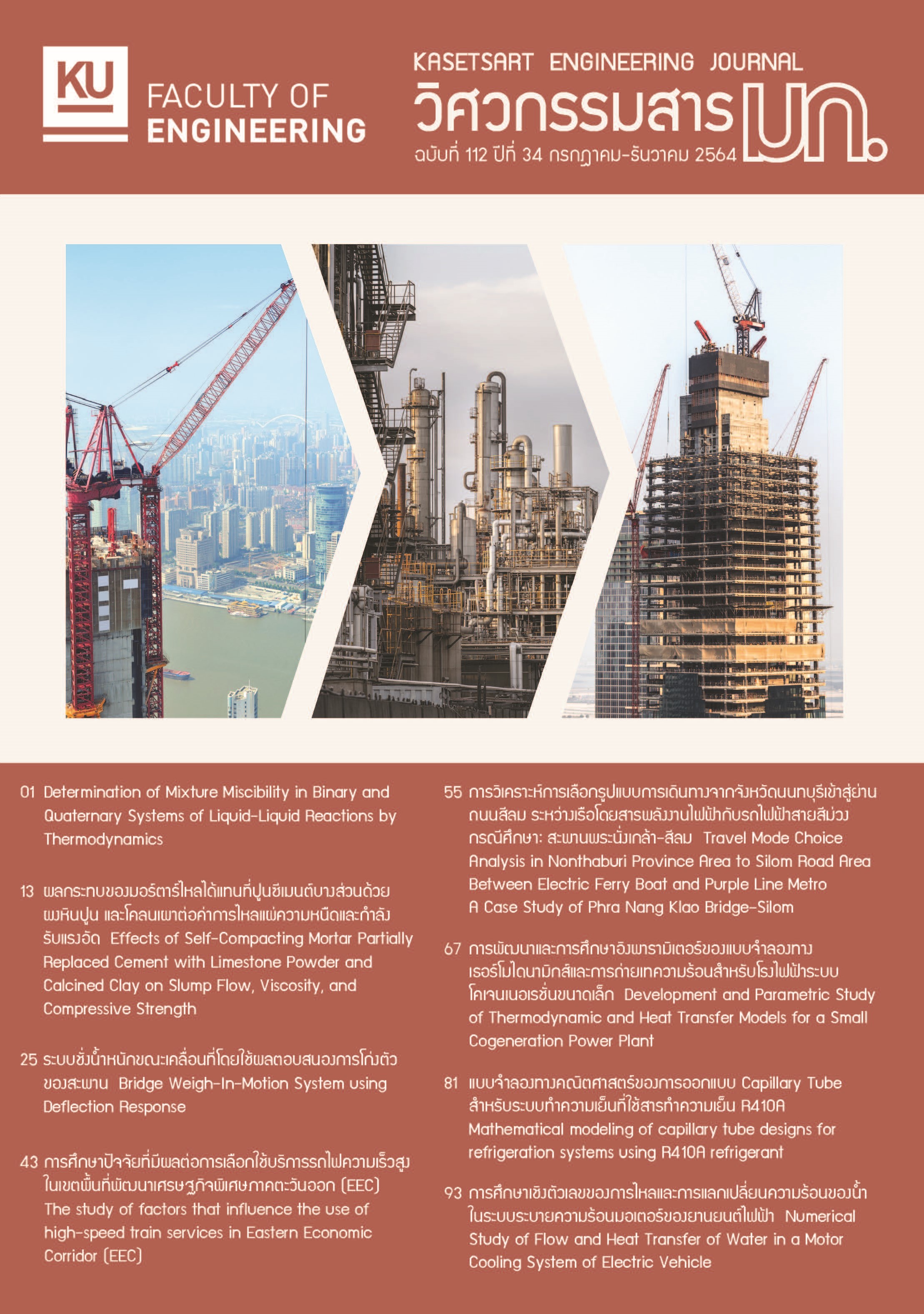ระบบชั่งน้ำหนักขณะเคลื่อนที่โดยใช้ผลตอบสนองการโก่งตัวของสะพาน
คำสำคัญ:
ระบบชั่งน้ำหนักขณะเคลื่อนที่โดยใช้สะพาน, การหาน้ำหนักเพลา, น้ำหนักรถบรรทุก, ผลตอบสนองการโก่งตัวของสะพานบทคัดย่อ
งานวิจัยนี้นำเสนอระบบชั่งน้ำหนักรถบรรทุกขณะเคลื่อนที่โดยใช้ผลตอบสนองการโก่งตัวของสะพานแทนการใช้ผลตอบสนองความเครียด โดยทำการวิเคราะห์ด้วยวิธียกกำลังสองน้อยที่สุดและวิธีเรกูลาร์ไรเซชั่น ซึ่งเพิ่มความถูกต้องด้วยเทคนิคการปรับปรุงองค์ประกอบทางสถิตซึ่งใช้เส้นอินฟลูเอนซ์ของสะพานที่ได้จากการตรวจวัดโดยตรง โดยศึกษาด้วยการจำลองในคอมพิวเตอร์ด้วยตัวอย่างเชิงตัวเลขและทำการประเมินประสิทธิผลจากการศึกษาเชิงสถิติ ผลการศึกษาพบว่าการใช้ผลการตอบสนองการโก่งตัวมีประสิทธิภาพดีกว่าการวิเคราะห์ด้วยสัญญาณความเครียด โดยสามารถเลือกใช้ค่าเรกูลาร์ไรเซชั่นที่เหมาะสมได้ในช่วงที่กว้างมากขึ้นโดยให้ความถูกต้องของการหาน้ำหนักที่สูงกว่า โดยปัจจัยที่พบว่ามีผลต่อความถูกต้องมากที่สุดคือระดับความขรุขระของผิวทางและระดับสัญญาณรบกวนจากการตรวจวัด โดยค่าความคลาดเคลื่อนแปรผันกับความขรุขระและระดับสัญญาณรบกวนจากการตรวจวัด ซึ่งสามารถลดความคลาดเคลื่อนได้โดยการปรับสภาพพื้นผิวสะพานให้มีความราบเรียบและใช้อุปกรณ์ตรวจวัดที่มีสัญญาณรบกวนต่ำหรือทำการกรองสัญญาณ การใช้ผลตอบสนองการโก่งตัวจึงเป็นอีกทางเลือกแทนการใช้มาตรวัดความเครียดที่อาจเกิดความคลาดเคลื่อนของสัญญาณจากการติดตั้งบริเวณที่เกิดรอยแตกร้าวขนาดเล็กของผิวคอนกรีตได้
References
Moses F (1979). Weigh-in-motion system using instrumented bridges. Journal of Transportation Engineering, 105(3): 233-249.
Law S S, Chan T H T, and Zheng Q H (1997). Moving force identification: A time domain method. Journal of Sound and Vibration, 201(1): 1-22.
Law S S, Chan T H T, and Zeng Q H (1999). Moving force identification - A frequency and time domains analysis. Journal of Dynamics Systems, Measurement, and Control, 121: 394-401.
Chan T H T, Law S S, Yung T H, and Yuan X R (1999). An interpretive method for moving force identification. Journal of Sound and Vibration, 219(3): 503-524.
Zhu X Q, and Law S S (2000). Identification of vehicle axle loads from bridge dynamic response. Journal of Sound and Vibration, 236(4): 705-724.
Chan T H T, Law S S, and Yung T H (2000). Moving force identification using an existing prestressed concrete bridge. Engineering Structures, 22(1): 1261-1270.
Law S S, Chan T H T, Zhu Q X, and Zeng Q H (2001). Regularization in moving force identification. Journal of Engineering Mechanics ASCE, 127(2): 136-148.
Law S S, Chan T H T, and Zeng Q H (2001). Regularization in moving force identification. Journal of Engineering Mechanics, 127(2): 136-148.
Zhu, X. Q., & Law, S. S. (2002). Moving Loads Identification Through Regularization. Journal of Engineering Mechanics ASCE, 128(5): 989-1000.
Law S S, and Fang Y L (2001). Moving force identification: Optimal state estimation approach. Journal of Sound and Vibration, 239(2): 233- 254.
Hansen P C (1993). The use of the L-curve in the regularization of discrete ill-posed problems. SIAM Journal on Scientific Computing, 14(6): 1457- 1503.
Law S S, Bu J Q, Zhu X Q, and Chan S L (2004). Vehicle axle loads identification using finite element method. Engineering Structures, 26(8): 1143-1153.
Yu L, and Chan T H T (2002). Moving force identification from bending moment responses of bridge. Structural Engineering and Mechanics, 14(2): 151-170.
Zhu X Q, and Law S S (2003). Identification of moving interaction forces with incomplete velocity information. Mechanical Systems and Signal Processing, 17(6): 1349-1366.
Pinkaew T (2006). Identification of vehicle axle loads from bridge responses using updated static component technique. Engineering Structures, 28(11): 1599-1608.
Asnachinda P, and Pinkaew T (2007). Experimental study on the identification of dynamic axle loads of moving vehicles from the bending moments of bridges. Engineering Structures, 29(9): 2282-2293.
Asnachinda P, Pinkaew T, and Laman J A (2008). Multiple vehicle axle load identification from continuous bridge bending moment. Engineering Structure, 30(10): 2800- 2817.
Deesomsuk T, and Pinkaew T (2009). Effectiveness of vehicle weight estimation from bridge weigh-in motion. Advances in Civil Engineering, Article no. 312034.
Deesomsuk T, and Pinkaew T (2010). Evaluation of effectiveness of vehicle weight estimation using bridge weigh-in-motion. The IES Journal Part A: Civil & Structural Engineering, 3(2): 96-110.
O’Brien E J, Quilligan M J, and Karoumi R (2006). Calculating an influence line from direct measurements. Proceedings of the Institution of Civil Engineers – Bridge Engineering, 159(1): 31-34.
O’Brien E J, Rowley C W, Gonzalez A, and Green M F (2009). A regularised solution to the bridge weigh in-motion equations. International Journal of Heavy Vehicle Systems, 16(3): 310-326.
Zhao H, Uddin N, O’Brien E J, and Shao X (2014). Identification of vehicular axle weights with a bridge weigh-in-motion system considering transverse distribution of wheel loads. Journal of Bridge Engineering ASCE, 19(3): paper ID 1943-5592.0000533.
Zhao H, Uddin N, and O’Brien E J (2017). Bridge weigh-in-motion algorithms based on the field calibrated simulation mode. Journal of Infrastructure Systems ASCE, 23(1): paper ID 04016021.
Deng L, and Cai C S (2010). Identification of dynamic vehicular axle loads: Theory and simulations. Journal of Vibration Control, 16(14): 2167-2194.
Deng L, and Cai C S (2010). Identification of dynamic vehicular axle loads: Demonstration by a field study. Journal of Vibration Control, 17(2): 183-195.
Asnachinda P, and Pinkaew T (2021). Vehicle axle load identification using extracted bridge influence line via updated static component technique. Engineering Journal, 25(5): 45-60.
Chen Z, Chan T H T, and Nguyen A (2018). Moving force identification based on modified preconditioned conjugated gradient method. Journal of Sound and Vibration, 423: 100-117.
Carraro F, Goncalves M S, Lopez R H, Miguel L F, and Valente A M (2019). Weight estimation on static B-WIM algorithms: A comparative study. Engineering Structures, 198: paper ID 109463, p.15.
Chudong P, Zhenjie H, Junda Y, Yisha L, and Yang L (2021). Moving force identification based on sparse regularization combined with moving average constraint. Journal of Sound and Vibration, 515: paper ID 116496, p.22.
Goncalves M S, Carraro F, and Lopez R H (2021). A B-WIM algorithm considering the modeling of the bridge dynamic response. Engineering Structures, 228:paper ID 111533, p.14.
Zhang Z, He W, and Ren W (2022). Moving force identification based on leaning dictionary with double sparsity. Mechanical Systems and Signal Processing, 170: paper ID 10881, p.17.
Jiang R J, Au F T K, and Cheung Y K (2003). Identification of masses moving on multi-span beams based on a genetic algorithm. Computers and Structures, 81: 2137-2148.
Kim S, Lee J, Park M S, and Jo B W (2009). Vehicle signal analysis using artificial neural networks for a bridge weigh-in-motion system. Sensors, 9: 7943-7956.
Zhang Q, Jankowski L, and Duan Z (2013). Simultaneous identification of moving vehicles and bridge damages considering road rough surface. Mathematical Problems in Engineering, 2013: paper ID 963424.
ISO 8608 (1995). Mechanical vibration-road surface profiles-Reporting of measured data. Geneva, Switzerland, International Standard Organization.
Downloads
เผยแพร่แล้ว
ฉบับ
บท
License

This work is licensed under a Creative Commons Attribution-NonCommercial-NoDerivatives 4.0 International License.

